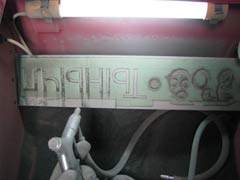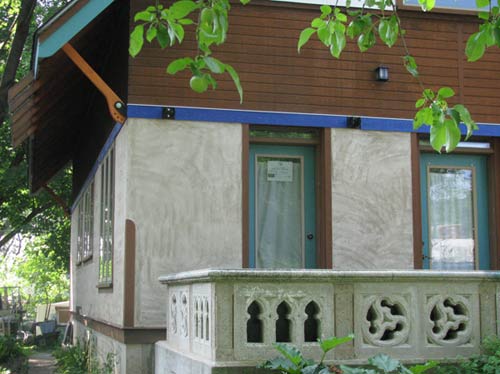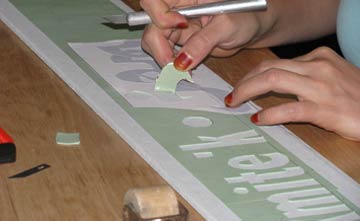 |
||||||
The Peace Band (above) Languages over the main entrance include Irish, Aramaic, Latin, Sanskrit and Polish (right) The black steel brackets are placed to receive the roof beams of the future glass-covered front porch |
|
|||||
Struggling with Language The project started with finding the written word "peace" in many languages. We began asking around of friends and colleagues, waiters in foreign-cuisine restaurants and the like. But we quickly shelved as impractical the notion of personally contacting all native speakers. So we turned to a comparision of internet sources. Wikipedia states that there are between 5,000 and 10,000 languages in the world. Obviously the available perimeter of house limited the number of languages we could include. Some words for "Peace" are very short -- the Tarawan (Micronesia) Rô , or the Navajo K'é -- but others are astonishingly long -- the Armenian Խաղաղություն and the Nahuatl (Aztec) Tlamatcanemiliztli. Averaged out and rendered at a readible scale, we calculated that our available space on the band would limit us to about 100 words. A few could be combined. For example, a half-dozen languages each share the words Mir and Pace. (Although they don't all write the word in the same way; Russians and others write mir as Мир.) At best we would be including only a fraction of the world's languages -- those with millions of speakers but also some from the more obscure groups. Click for a list of languages we included, and more... (PDF, 290K) Never mind the possibility of different translations of the concept (Do we mean "inner peace"? Or rather civic harmony? Or merely absense of active war? Etc...), the sheer number and variety of words is bewildering. Unlike the typical U.S.citizen, many people worldwide speak multiple languges, and there abound many close variants of superficaially similar words. Other difficulties became apparent. The internet and indeed computer software in general does not yet have a comprehensive format for accurately rendering text in all of the many scripts used worldwide. If you are having difficulty reading some of the text on this page, you have a sense of the problem. When we could, we attempted to confirm the correct appearance of a word in text by also finding a pictoral representation somewhere. This proved difficult for many languages however. The narrow horizontal format of the project meant that the layout would place limits on ascending and decending letter-parts. Each word would need to be composed separately and carefully to fit but still be legible. For unfamiliar word-forms, this often entailed some creative graphic design, i.e. guessing. The dangers of such guessing became clear when Bill/Lou was Photoshopping some words in the Devanagari script (used for Hindi, Gujarti, Punjabi, Sanskrit and others). Day, who is studying Hindi, noticed some of the diacritical marks common to Devanagari had become distorted enough to in fact create different words, or nonsense. We realized then that, whereas we could confidently adjust the shape of words in the Latin alphabet, we must hew rigidly to the given shapes of all other scripts, and trust to the accuracy of the text as rendered from our internet sources. Then there's the problem of written scripts versus spoken language -- for example, "shakti" (as the word is pronounced in English) is common to a number of South Asian languages. It's apparently pronounced similarly in many, but is written diffently. A similar situation occurs with "salaam" or "shalom". Different tongues write in a variety of beautiful scripts; the same word appears to us in differnt, "arabic-looking" forms . And some languages from oral traditions, such as many North- and South-American Indian tongues, have no written analog, or necessarily standardized spellings. We had to decide on a suitable transliteration using the Latin alphabet. Then we needed to choose a lettering style that would hopefully "feel" correct for that language. In the process we have no doubt incorporated the errors of others and made some of our own -- of spelling, script or appropriateness. In the years to come, we hope that native speakers will point these out and forgive us. Then we'll need to decide how to carve repairs. Eventually we'll create a handout that lists all of the words we used and their respective languages and countries. Out of all this, our main goal remained: to the extent space allowed, we hoped that every person who might visit the house, from any land on Earth, would be able to to find at least one "peace" in a language that they recognized. |
||||||
Fabrication
|
||||||
 |
||||||
Inexpensive abrasive-blasting cabinet, modified with slots cut into the sides for continuous feed of 12-foot long pieces. |
||||||
|
 |
 |
||||
Feeding in the masked workpiece... |
...then blasting it inside the cabinet.... |
....and letters emerge carved deep. |
||||




 Comments? lou@designcoalition.org
Comments? lou@designcoalition.org